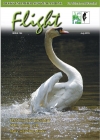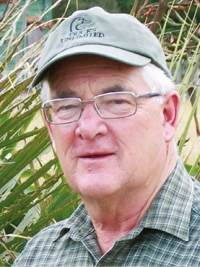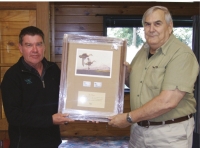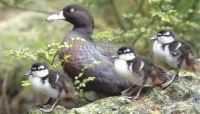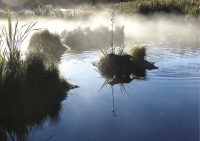I recently returned from a day looking at some coastal rivers and wetlands in Hawke’s Bay with Regional Council staff. On this occasion the focus was not birds but whitebait, and in particular inanga. Inanga are one of five species of native fish that make up the national whitebait catch. In my region inanga make…
Published in
Issue 164
Tagged under
Are you ready for the Ducks Unlimited 41st AGM 2015, Conference and Dinner, July 31 to August 2. The Distinction hotel in Palmerston North is the venue. The rooms are comfortable, and the food is excellent. Yip – I have eaten there. A bus trip to view the lovely Rangiwahia Wetlands is a scenic ride…
Ducks Unlimited New Zealand 40th Annual General Meeting 2 August 2014 9am at Brackenbridge Conference Centre, Martinborough. Welcome: The President John Cheyne, welcomed members to the 40th Annual General Meeting. Apologies: Ian, Dawn and Paul Pirani, Nancy Payne, James and Di Martin, Dan Steele, Anne Russell, Chris Bindon, Clare Worth Motion: That the apologies tendered…
It gives me great pleasure in presenting my annual report for 2014-15. As you will read we are not short on challenges. Over the last 12 months we have had a number of highs and the odd low. Starting with the low, we have the same problem faced by DU Canada, DU USA and many…
The Wairio Wetland Restoration has taken another step forward with the completion of the 1.7 km Bund Wall linking Stage 1 and Stage 4. If it is as successful as the Bund in Stage 4 we will have another 15 to 20 hectares of shallow open water with low islands scattered throughout. This type of…
Published in
Issue 164
Tagged under
At a fairly recent DU Manawatu Chapter dinner, our president John Cheyne successfully bid for a weekend at Jim Campbell’s (one of DU’s patrons), lodge near Mount Bruce in northern Wairarapa. “I last visited Jims property in 1982,” John said. “It was soon after the pond had been constructed and was unfenced and not planted.…
Published in
Issue 164
Did You Know? Ducks Unlimited was incorporated by Joseph Knapp, EH Low and Robert Winthrop in January 29, 1937, in Washington, DC, USA as a result of their concerns (and those of other sportsmen), about the loss of wetlands as habitat for waterfowl and the impact this would have on waterfowl hunting. Ducks Unlimited…
Published in
Issue 164
Tagged under
Ian Pirani received a Queens Service Medal (QSM) in this year’s Queen’s Birthday honours for services to conservation. In 1974 Ian was a co-founder of Ducks Unlimited and was the first president of DUNZ through to 1980. During this time he and his wife Dawn initiated a Pateke breeding programme and nesting boxes for…
Fine weather was ideal for a ‘planting’ day at Ruffit Lodge (east of Woodville) mid May, with a few neighbours, friends and family mucking in to help. 160 trees were planted, with most getting the Don Bell ‘Growtector’ treatment. “This is the last section of our waterway to be fenced and planted. Just a few…
Published in
Issue 164
Tagged under
Rickie Cameron 10, Omamari, Kaipara. “He has been out previously (not shooting), but never opening weekend.” Rickie is David Cameron’s son. They live in Silverdale. “This was his first opening weekend and he was shooting with a Optima 410 single barrel shotgun and his trusty Ridgeline gear. It was on private land,…
Published in
Issue 164
Tagged under
Glen Butts at Lake Koromatua. “I have been shooting there for 33 years, the Maimai was rebuilt about 1992 by Murray Davies who uses the Maimai from the second weekend. In the foreground is my nephew Murray Butts and behind him is my son Craig Butts. Opening weekend always sees a few birds for…
Dianne's dogs
Hi all, Another release in March with four birds on the Tongariro and the other four on the Whakapapa not far from the Chateau. Because we had so many people we split the release on the Whakapapa and released two birds at each site about 200m apart. It was another fantastic day.…
Just thought I’d fill you in with a couple of the shots taken of our Weedbusting along the Mahurangi River, Warkworth. Mardieraa Vine produced wee tubers that then drop to the ground. Dreadful thing! Convolvulus – another dreadful invasive vine. And then there is privet, both tree and bush growing along the river…
The whio or blue duck, which features on our $10 note, is endemic to New Zealand. Rarer than some species of kiwi, with an estimated population of under 3000, it is nationally vulnerable and faces the risk of becoming extinct. Their Maori name is whio whio, and they are found nowhere else in the…
Published in
Issue 164
Tagged under
Call to bring back lead shot for duck shooting On the eve of the duck shooting season New Zealand First repeated its call for the restoration of lead shot. “Many shooters say the steel shot does not always kill and birds may die over hours or days,” said spokesperson on Outdoor Recreation Richard Prosser.…
Published in
Issue 164
Tagged under
Five plumed whistling ducks were sighted on a Kokatahi farm near Hokitika on the South Island’s west coast a few weeks ago and reported to the Department of Conservation. These plumed whistling ducks are a striking waterfowl species endemic to Australia. Formerly considered of rare occurrence in New Zealand (recorded eight time during…
Published in
Issue 164
Wasps are one of the most damaging invertebrate pests in New Zealand; they harm our native birds and insects and compete for food with our native species. If you put together all the wasps in honeydew beech forests they would weigh more than the weight of birds, rodents and stoats combined. This new study…
Published in
Issue 164
Tagged under
Kiwi deaths at Pukaha We are saddened to let you know that we are currently dealing with a suspected ferret incursion at Pukaha with the death of 7 kiwi (3 juvenile and 4 adult) since March 2015. The juvenile kiwi deaths include the two white kiwi hatched in the wild in February this year. …
Published in
Issue 164
Tagged under
Boggy Pond, Matthews lagoon, Wairio Wetlands, JK Donald Reserve and Barton’s Lagoon. These areas in the east and north of Lake Wairarapa are regarded as the best examples of native wetlands left at Wairarapa Moana. All are on public conservation land and have infestations of pet plants to some degree – alder, willow, hornwort,…
Agricultural runoff often results in large concentrations of phosphorous and nitrates making their way into local waterways. But new research suggests wetlands can help stem the tide of leaching fertilisers. In a recent two-year study, conducted by researchers at the University of Illinois, local wetlands helped reduce the amount of nitrates leaking into the…
Published in
Issue 164
Kindara, the uniquely ginger coloured kiwi chick at his stoat-proof weight was released back into the wild. The ginger Kiwi has unique colouring and this tickled the fancy of red head Emma Bean who works at the Rainbow Springs Kiwi Encounter where Kindara’s egg was incubated and hatched. Emma made the trip to Ohakune…
Last April, I was able to complete the servicing round down at Boggy Pond, Mathews and the Wairio Restoration Block. The total predators trapped there for the month was : 1 cat, 5 ferrets, 1 weasel, 9 rats, 29 hedgehogs, 6 mice and 1 hawk. While there I GPS’d another eight potential trapping…
Published in
Issue 164
Tagged under

